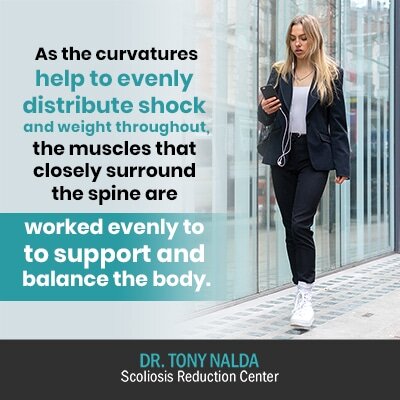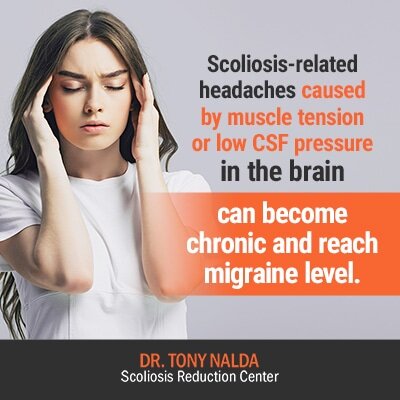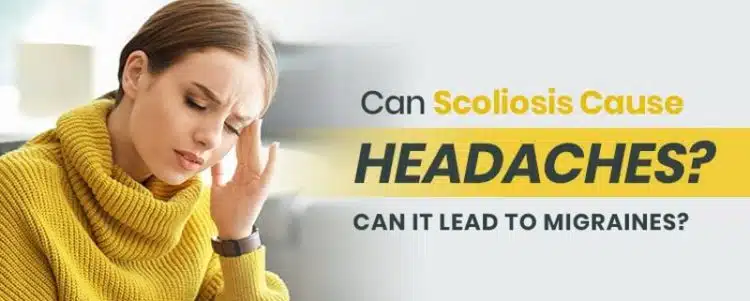As a scoliosis specialist, I’ve treated all forms of the condition, not to mention addressed numerous scoliosis-related symptoms. Read on to learn how some symptoms that might seem unrelated to scoliosis can develop, such as headaches and migraines.
The spine is an important part of the central nervous system, and as a spinal disorder, scoliosis has the potential to cause numerous symptoms felt throughout the body. Scoliosis-related headaches can be a common complaint, including tension headaches and/or migraines caused by muscle strain or disruptions to cerebrospinal fluid flow.
While most people have heard of scoliosis, many would assume the condition’s effects would be limited to the spine. Before we move on to the specifics of scoliosis-related headaches and migraines, let’s first explore the role of the spine and some basic spinal anatomy.
Role of the Spine
What role do the natural curves of the spine play in every-day life and overall health? What does the spine do anyway?
These questions are simple ones, but they have complex answers. This is because the spine is an extremely important part of the body’s overall health and function.
A healthy spine impacts the body in multiple ways. It helps us maintain a healthy and upright posture, move around easily, and allows for optimal functioning of the CNS and the body’s organs.
This is why spine-health is such an important part of overall health and wellness.
Before we move on to some basic spinal anatomy, let’s first consider the roles of the spine in facilitating movement and the function of the central nervous system (CNS).
Facilitating Movement
So what does the human spine do? It gives our bodies structure, support, and balance, for one.
It also makes it possible for us to move around easily, bend and twist, and engage in flexible movement.
Central Nervous System Function
The brain and spinal cord work together to form the central nervous system, which plays a role in virtually every working system within the body.
The spine also protects the spinal cord: a column of nerves connecting the brain to the rest of the body so that messages can be relayed back and forth.
The CNS controls reflexes, general movement, organ function, and the mind through a complex communication network.
The brain is the nucleus of our thoughts and mental health; it is also the means by which we interpret the external environment with our internal responses.
Now that we have looked at the significant roles the spine plays in the overall health and function of the body, let’s take a look at some basic spinal anatomy; this will help us get a clear understanding of how scoliosis affects the spine, and how those effects can be expressed throughout the body.
Basic Spinal Anatomy
The spine is made up of three main sections: cervical spine (neck), the thoracic spine (upper and middle back), and the lumbar spine (lower back).
Each section has its own characteristic natural and healthy curve, and when one of those curves is lost, it affects the spine’s overall biomechanics.
If you look at a healthy spine from the side, you will see that it has a soft ‘S’ shape. This shape is made by the spine’s inward curves (lordosis) and outward curves (kyphosis).
Healthy lordosis is seen in the two forward curves of the cervical (neck) and lumbar spine (lower back). Healthy kyphosis curves are found in the two backward curves of the thoracic (chest area) spine and the sacral spine (hip area).
These natural and healthy curves serve three primary functions.
Role of the Spinal Curvatures
The spine’s healthy curvatures facilitate flexible movement and help us maintain a straight and upright posture.
The spinal curvatures work together in a spring-like function, and this makes it possible for the spine to absorb and evenly distribute shock and impact.

If the spine was straight with no curves, it would take on a lot of degenerative wear due to the uneven distribution of mechanical stress. This would lead to spinal injuries such as fractures and worse.
As the curvatures help to evenly distribute shock and weight throughout, the muscles that closely surround the spine are worked evenly to support and balance the body.
These concepts are particularly evident when engaging in dynamic movements.
With dynamic movements such as bending, turning, twisting, and lifting, the spine is required to coordinate with the rest of the body, but it has to do all this while supporting the body’s weight and distributing the transfer of energy caused by the dynamic movements.
The curves of the spine help to evenly distribute shock and weight throughout so that no one section is getting overworked.
The curves of the spine also help preserve the intervertebral discs.
The intervertebral discs sit between the bones that make up the spine: vertebrae. The discs help to cushion each individual vertebra so they are not rubbing up against each other.
They also help absorb the stress and shock that occurs during movement.
So the spine’s healthy curves serve the following functions: help support and balance the body, facilitate flexible movement, and evenly distribute weight and shock, preserving the intervertebral discs.
Now that we understand the basics of spinal anatomy, including the role of the spine’s healthy curves, let’s extend that understanding to scoliosis and common related symptoms, such as headaches, that can occur.
Scoliosis Symptoms
When scoliosis is first diagnosed, it’s classified as either mild, moderate, or severe. This designation is given based on a patient’s X-ray results and their Cobb angle measurement.
As the gold standard for assessing scoliosis, a patient’s Cobb angle expresses, in degrees, how far out of alignment their spine bends and twists and classifies the condition on its severity scale:
- Mild scoliosis – Cobb angle measurement of between 10 and 25 degrees
- Moderate scoliosis – Cobb angle measurement of between 25 and 40 degrees
- Severe scoliosis – Cobb angle measurement of 40+ degrees
Generally speaking, the more severe a person’s condition is, the more likely it is to produce noticeable symptoms; however, scoliosis is not always a predictable condition as two patients with similar Cobb angles can experience very different symptoms.
While headaches are one of the more common complaints of people with scoliosis, that doesn’t mean every person with scoliosis will automatically struggle with headaches and/or migraines; every case is different.
Can Scoliosis Cause Headaches?
As previously mentioned, scoliosis affects the central nervous system because it involves the spine, an integral component of the body’s communication system.
As the CNS affects virtually all of the body’s systems, some seemingly unrelated symptoms can occur.
So to answer the question of can scoliosis cause headaches and lead to migraines: yes, it can.
There are two main ways that scoliosis can cause headaches: tension headaches due to muscle strain, and low CSF pressure headaches.
Tension Headaches
While scoliosis most commonly develops along the thoracic spine (middle-upper back), it can also develop along the cervical and lumbar spine.
Particularly common with abnormal curvatures of the cervical spine, muscle tension can become a factor as the neck muscles try to overcompensate to support the stressed spine and the weight of the head.
As mentioned earlier, the spine’s healthy curves help evenly distribute shock and weight. If there is a loss of the neck’s healthy curvature and it slants forward as a result, it’s no longer able to properly support the weight of the head.
This shift in posture increases the workload for the muscles closely attached to the cervical spine.
Over time, this can lead to muscle imbalance, which can make the neck muscles feel overly tight, sore, and cause tension headaches to develop.
Especially if left untreated, as the condition progresses, scoliosis-related tension headaches can escalate to debilitating levels.
Low CSF Pressure Headaches
Cerebrospinal fluid is a clear liquid found in and around the spinal cord and brain.
CSF helps to protect the brain and spinal cord, hence preserving the function of the central nervous system.
CSF lives in the subarachnoid space and ventricular system that is inside, and surrounds, the brain and spinal cord.
The colorless liquid fills the brain’s ventricles, sulci, cisterns, and the spinal cord’s central canal.
CSF acts as a cushion that protects the central nervous system; this cushioning effect protects the brain and spine from injury.
It’s also in charge of removing waste from the brain, and this helps maintain the healthy functioning of the CNS.
As scoliosis causes an abnormal curvature of the spine to develop, this can disrupt the flow of CSF through the spinal cord’s central canal.

When there is a disruption to the flow of CSF through the spinal canal, CSF pressure in the brain can drop, causing debilitating headaches to occur.
Scoliosis-related headaches caused by muscle tension or low CSF pressure in the brain can become chronic and reach migraine level.
Can Scoliosis Cause Migraines?
Although anyone who has had a true migraine knows how different they are from an average headache, many people don’t fully understand the difference.
Typical headaches are defined as pains in the head that can cause feelings of pressure and discomfort. They can occur on one or both sides of the head and can affect the temples, forehead, and the back of the neck.
Average headaches can last as little as 30 minutes, can last for days, or come and go.
Common triggers for headaches can be tension, stress, muscle strain, and anxiety.
Migraines are characterized as severe headaches that are intense, generally last for long periods of time, and are accompanied by a number of migraine-specific symptoms: nausea and vomiting, temporary vision loss, numbness and tingling in the face and/or arms, sensitivity to light, movement, and more.
Most commonly, migraine headaches affect one side of the head more, but can also be felt on both sides.
In comparison with regular headaches, migraines can last for longer periods of time, be far more intense, and cause debilitating pain to the point where a person has difficulty moving and fulfilling daily responsibilities.
Some migraine-sufferers also get a number of signs days, or moments, before the migraine strikes. These most commonly include the presence of an aura, which can look like swirling bright-colored lights.
Some also report having a hole in their visual field and numbness in the hands and/or face that warn them of an impending migraine, while others describe disruption to their speech and feelings of being overly emotional or confused.
Whether due to muscle tension or low CSF pressure in the brain, scoliosis has the potential to cause both regular headaches and migraines to occur, and either can escalate to debilitating levels.
Conclusion
Scoliosis can cause numerous symptoms and potential complications, especially if left untreated.
When it comes to the question of if scoliosis can cause headaches and lead to migraines, the answer is ‘yes’, it most certainly can.
Whether due to extra strain on the neck muscles that support the weight of the head, or an impairment to the flow of CSF causing low CSF pressure in the brain, scoliosis-related headaches and migraines can be highly unpleasant.
For those suffering from scoliosis-related headaches and/or migraines, a visit to the Scoliosis Reduction Center® and engaging in our functional treatment approach can help alleviate those symptoms as we restore the spine’s healthy curves.





